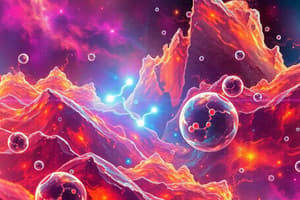Podcast
Questions and Answers
Which of the following changes is identified as a chemical change?
Which of the following changes is identified as a chemical change?
- The Colorado river eroding rocks
- Mixing cinnamon and sugar
- Snow melting
- Meat that is left out spoiling (correct)
What property is indicated by the ability of a substance to catch fire?
What property is indicated by the ability of a substance to catch fire?
- Density
- Flammability (correct)
- Dissolution
- Conductivity
Which of the following is a physical property of a substance?
Which of the following is a physical property of a substance?
- Flammability
- Luster/shine (correct)
- Rusting
- Reactivity with acid
How can density be expressed mathematically?
How can density be expressed mathematically?
What distinguishes a phase change from a chemical change?
What distinguishes a phase change from a chemical change?
Which model of atomic structure was improved by the introduction of the quantum model?
Which model of atomic structure was improved by the introduction of the quantum model?
Which of the following indicates a physical change when a substance is subjected to it?
Which of the following indicates a physical change when a substance is subjected to it?
Which liquid has the highest density based on the given measurements?
Which liquid has the highest density based on the given measurements?
Which of the following processes is NOT typically a chemical change?
Which of the following processes is NOT typically a chemical change?
What best describes how the Quantum Model differs from the earlier models of atomic structure?
What best describes how the Quantum Model differs from the earlier models of atomic structure?
Flashcards
Chemical Change
Chemical Change
A change that alters the chemical composition of a substance, resulting in a new substance with different properties.
Physical Change
Physical Change
A change that only alters the physical appearance of a substance, but not its chemical composition. The substance remains the same.
Density
Density
A measure of how much mass is contained in a given volume. It's a fundamental property of matter.
Flammability
Flammability
Signup and view all the flashcards
Reactivity
Reactivity
Signup and view all the flashcards
Conductivity
Conductivity
Signup and view all the flashcards
Luster
Luster
Signup and view all the flashcards
Solubility
Solubility
Signup and view all the flashcards
Melting
Melting
Signup and view all the flashcards
Freezing
Freezing
Signup and view all the flashcards
Study Notes
Chemistry Final Review
- AKS 2a: Plan and carry out an investigation about physical and chemical properties at the macroscopic scale.
- Identify the following as chemical or physical change:
- Colorado River eroding rocks (Grand Canyon): Physical
- Spoiled meat: Chemical
- Snow melting: Physical
- Mixing cinnamon and sugar: Physical
- Identify the following as chemical or physical change:
- AKS 2b: Use mathematics, computational, and conceptual thinking to calculate density.
- Density: Mass per unit volume (D=M/V)
- Physical vs. Chemical Changes/Properties
- Freezing: Physical
- Dissolving in water: Physical
- Flammability: Chemical
- Tarnishing of silver: Chemical
- Luster/Shine: Physical
- Density: Physical
- Conductivity: Physical
- Making an alloy: Physical
- Phase Changes:
- Phase changes are physical changes
Atomic Models
- Plum Pudding Model: Added electrons and positive charge.
- Nuclear Model: Added empty space and a positive central nucleus.
- Planetary Model: Organized electrons in orbitals/shells.
- Quantum Model (Modern-day electron cloud model): Shows electrons do not move in fixed shells.
Physical Properties/Measurement
- Ways to determine physical properties: Measure density, mass, volume, conductivity, etc.
- Chemical Properties: flammability and reactivity
Density of Liquids
- Mercury: 13.6 g/mL
- Water: 1.02 g/mL
- Ethyl alcohol: 0.79 g/mL
- Water: 1.00 g/mL
- Gasoline: 0.7 g/mL
- Chloroform: 1.49 g/mL
Studying That Suits You
Use AI to generate personalized quizzes and flashcards to suit your learning preferences.




